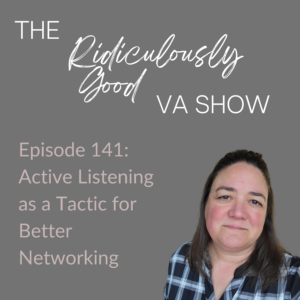Welcome to another episode of the podcast that teaches you how to be a ridiculously good virtual assistant.
Today I want to talk about communication, and in particular the listening part of communicating. Active listening.
Today’s Quote: When people talk, listen completely. Most people never listen. – Ernest Hemingway
Click the play button above to tune in, or choose your favourite podcast player below:


Connect with Tracey D’Aviero, VA Coach and Trainer




Episode Notes:
Today we’re jumping into a really important skill that can completely transform the way you connect with potential clients, collaborators, and fellow VAs. That skill? Active listening.
Networking isn’t just about talking and pitching yourself.
It’s about making meaningful connections, and one of the best ways to do that is by being a great listener.
In this episode, we’ll talk about why active listening is such a powerful tool for virtual assistants, how to develop it, and how to use it to build stronger business relationships.
Why Active Listening Matters in Networking
Networking is often seen as promoting yourself—your services, your skills, your expertise, but the real secret to successful networking is not in the talking, but in the listening.
Why? Because when you truly listen to someone, you make them feel heard, valued, and understood. And that creates trust, which is the foundation of any strong business relationship.
Here’s what active listening does for you as a VA:
It helps you identify real pain points. Instead of assuming what a potential client needs, you hear exactly what their struggles are, allowing you to position your services as the perfect solution.
It makes you more memorable. People appreciate those who genuinely listen. When you reflect back their concerns and show understanding, they’re more likely to remember you—and recommend you.
It builds rapport faster. When people feel heard, they naturally gravitate toward you, making it easier to nurture leads and establish professional relationships.
I remember having a conversation with a business owner once about their business, and my services. I was fairly new at networking, and I was still trying to figure out when to fit the ‘pitch’ in.
It was what I was taught, and I didn’t know any other way to get to the part where I told them about my services. I knew they were a coach in my network of coaches.
I knew I could help them, because I was helping their colleagues.
But this one was different. She didn’t use the same platforms, she wasn’t finding her clients the same way as some of my other clients, and she wasn’t a pushy coach like so many are.
She was what I would now call a heart centred entpreneur, coach.
So we talked. She knew what she wanted in terms of support, but what we mostly talked about was that she had hired two other VAs and they had not worked out for her. She joked that her husband said if she hired me and I didn’t work out, then the common denominator was her, and she would have to admit that she was the problem!
The important part to her was that we could work together. I listened much more to her than I had to others in that coaching circle, and when I did I was able to truly address the issues that were most important to her.
Oh yeah, and we went on to work together for 7 years. So I call that a win!
The Components of Active Listening
Active listening is more than just hearing words—it’s about fully engaging in a conversation. Here are the key components:
1-Give Your Full Attention
Minimize distractions. If you’re on a Zoom call, silence notifications and maintain eye contact.
Use nonverbal cues like nodding and smiling to show engagement.
2-Listen Without Interrupting
Resist the urge to jump in with advice or your own story—let them finish their thoughts first. Keep a notepad if you really need to jot down something you want to refer back to, but don’t let it distract you.
Practice patience; pauses in conversation don’t always need to be filled.
3-Reflect and Clarify
Paraphrase what they said to confirm understanding. Example: “So what I’m hearing is that you’re struggling with managing your social media content consistently. Is that right?”
Ask clarifying questions like, “Can you tell me more about that?” to show genuine interest and to expand the conversation.
4-Respond Thoughtfully
Instead of rushing to pitch your services, acknowledge their concerns first. “That sounds frustrating—I can see why that would be a challenge.”
Share insights that align with their needs rather than a generic sales pitch. “Here’s how I help my clients.”
How to Use Active Listening in Networking Settings
So, how do you apply active listening when networking—whether online or in person? Here are a few key situations:
1-During Discovery Calls
Focus on uncovering your potential client’s biggest challenges by asking open-ended questions and really listening to their answers.
Avoid rushing into solutions before they’ve fully explained their needs. Ask clarifying questions where needed.
2-At Virtual or In-Person Networking Events
When engaging in group discussions, pay attention to what others are saying rather than thinking about what you’ll say next.
When you do speak, refer back to something someone else said to show you were truly listening. Example: “I really liked what Julie said about time blocking. I’ve found that helpful too!”
3-In Online Communities and Social Media Interactions
Instead of dropping links to your services right away, respond to posts with thoughtful insights and questions.
If someone posts about a struggle, acknowledge their frustration and ask follow-up questions before offering a suggestion. Create a mini conversation.
4-When Following Up
When you reconnect with someone, reference something they mentioned previously to demonstrate that you were truly listening. Example: “Last time we talked, you were struggling with content scheduling—how’s that going?”
The more you do it, the easier it gets. So I will still always advise you to have as many conversations as you can. These examples above are all different kinds of conversations that require active listening – or at least that benefit from it.
Challenge and Practicing Active Listening
Active listening sounds simple, but in reality, it takes practice. Here are some common challenges and how to overcome them:
If your mind wanders during conversations, try summarizing their words in your head as they speak to stay focused. Use that notepad, but not so much that it distracts you.
If you get distracted by thinking about what to say next, pause before responding, and remind yourself that listening comes first. I’ve definitely had to work on this over the years.
If you struggle with virtual cues in online networking, use verbal affirmations like “I see what you mean” or type comments in chat to stay engaged.
A great way to practice is by role-playing networking conversations with a friend or fellow VA. You can also listen to podcast interviews or watch business discussions, focusing on how skilled communicators use active listening techniques.
Another important point:
A good podcaster or interviewer doesn’t cut off their guests – I like to think I’m a good interviewer. I don’t do it as much as I used to but as a coach, I often mediate our group sessions – CAVA group networking, my live workshops, my mastermind group – and it’s important to let people get their thoughts out and keep things on track.
You also need to do that when you are talking to clients. Letting them talk doesn’t mean letting them ramble. When you host a meeting, you create an agenda to keep things on track.
In your conversations, you want to focus on being succinct too. It takes practice, but you’ll get there!
Alright, let’s recap:
- Active listening is one of the most powerful networking tools for VAs.
- It helps you uncover client pain points, understand their real issues, build rapport, and make lasting connections.
- Key components include giving your complete and full attention, listening without interrupting, reflecting, and responding thoughtfully. It’s a bit of a cycle to focus on in every conversation you have.
- You can apply active listening in discovery calls, networking events, online communities, and follow-ups. You can also apply it your personal conversations, and in fact this can help you practice it more often!
- Like any skill, it takes practice—but the results are worth it!
And as always, let’s circle back on today’s quote: When people talk, listen completely. Most people never listen. Ernest Hemingway is right – listen to the next conversations that happen around you. Listen to how people talk, how the people they are talking to listen (or don’t).
Watch what people type in social media comments. It’s alarming to see how when someone says they are looking for VA help for instance, and they say to email them, that some VAs say ‘DM’d you’. They aren’t listening.
Or when someone says on Threads I’m so excited, I’ve decided to hire a VA this year, and then their comments and DMs are filled with pitches. That’s not the response to that conversation starter (all social media posts are conversation starters, did I say that?)
Now, I’d love to hear from you!
Have you ever had a networking experience where active listening made a big difference?
Share your thoughts with me on social media or in my VA community—I’d love to continue the conversation.
Do You Need Help?
If you found this episode helpful, don’t forget to subscribe and leave a review. And if you’re looking for more strategies to build your VA business with confidence, check out my coaching programs and resources at YourVAMentor.com.
I am here to help – it’s what I always tell you, it’s the only reason I’m here at all – to help you become a ridiculously good virtual assistant.
Thanks for tuning in, I’m Tracey D’Aviero, Confidence Coach for VAs and I’ll see you next time!